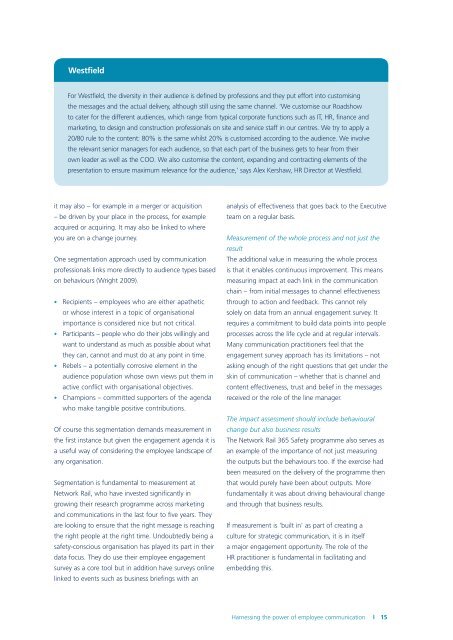Harnessing the power of employee communication - CIPD
Harnessing the power of employee communication - CIPD
Harnessing the power of employee communication - CIPD
You also want an ePaper? Increase the reach of your titles
YUMPU automatically turns print PDFs into web optimized ePapers that Google loves.
Westfield<br />
For Westfield, <strong>the</strong> diversity in <strong>the</strong>ir audience is defined by pr<strong>of</strong>essions and <strong>the</strong>y put effort into customising<br />
<strong>the</strong> messages and <strong>the</strong> actual delivery, although still using <strong>the</strong> same channel. ‘We customise our Roadshow<br />
to cater for <strong>the</strong> different audiences, which range from typical corporate functions such as IT, HR, finance and<br />
marketing, to design and construction pr<strong>of</strong>essionals on site and service staff in our centres. We try to apply a<br />
20/80 rule to <strong>the</strong> content: 80% is <strong>the</strong> same whilst 20% is customised according to <strong>the</strong> audience. We involve<br />
<strong>the</strong> relevant senior managers for each audience, so that each part <strong>of</strong> <strong>the</strong> business gets to hear from <strong>the</strong>ir<br />
own leader as well as <strong>the</strong> COO. We also customise <strong>the</strong> content, expanding and contracting elements <strong>of</strong> <strong>the</strong><br />
presentation to ensure maximum relevance for <strong>the</strong> audience,’ says Alex Kershaw, HR Director at Westfield.<br />
it may also – for example in a merger or acquisition<br />
– be driven by your place in <strong>the</strong> process, for example<br />
acquired or acquiring. It may also be linked to where<br />
you are on a change journey.<br />
One segmentation approach used by <strong>communication</strong><br />
pr<strong>of</strong>essionals links more directly to audience types based<br />
on behaviours (Wright 2009).<br />
• Recipients – <strong>employee</strong>s who are ei<strong>the</strong>r apa<strong>the</strong>tic<br />
or whose interest in a topic <strong>of</strong> organisational<br />
importance is considered nice but not critical.<br />
• Participants – people who do <strong>the</strong>ir jobs willingly and<br />
want to understand as much as possible about what<br />
<strong>the</strong>y can, cannot and must do at any point in time.<br />
• Rebels – a potentially corrosive element in <strong>the</strong><br />
audience population whose own views put <strong>the</strong>m in<br />
active conflict with organisational objectives.<br />
• Champions – committed supporters <strong>of</strong> <strong>the</strong> agenda<br />
who make tangible positive contributions.<br />
Of course this segmentation demands measurement in<br />
<strong>the</strong> first instance but given <strong>the</strong> engagement agenda it is<br />
a useful way <strong>of</strong> considering <strong>the</strong> <strong>employee</strong> landscape <strong>of</strong><br />
any organisation.<br />
Segmentation is fundamental to measurement at<br />
Network Rail, who have invested significantly in<br />
growing <strong>the</strong>ir research programme across marketing<br />
and <strong>communication</strong>s in <strong>the</strong> last four to five years. They<br />
are looking to ensure that <strong>the</strong> right message is reaching<br />
<strong>the</strong> right people at <strong>the</strong> right time. Undoubtedly being a<br />
safety-conscious organisation has played its part in <strong>the</strong>ir<br />
data focus. They do use <strong>the</strong>ir <strong>employee</strong> engagement<br />
survey as a core tool but in addition have surveys online<br />
linked to events such as business briefings with an<br />
analysis <strong>of</strong> effectiveness that goes back to <strong>the</strong> Executive<br />
team on a regular basis.<br />
Measurement <strong>of</strong> <strong>the</strong> whole process and not just <strong>the</strong><br />
result<br />
The additional value in measuring <strong>the</strong> whole process<br />
is that it enables continuous improvement. This means<br />
measuring impact at each link in <strong>the</strong> <strong>communication</strong><br />
chain – from initial messages to channel effectiveness<br />
through to action and feedback. This cannot rely<br />
solely on data from an annual engagement survey. It<br />
requires a commitment to build data points into people<br />
processes across <strong>the</strong> life cycle and at regular intervals.<br />
Many <strong>communication</strong> practitioners feel that <strong>the</strong><br />
engagement survey approach has its limitations – not<br />
asking enough <strong>of</strong> <strong>the</strong> right questions that get under <strong>the</strong><br />
skin <strong>of</strong> <strong>communication</strong> – whe<strong>the</strong>r that is channel and<br />
content effectiveness, trust and belief in <strong>the</strong> messages<br />
received or <strong>the</strong> role <strong>of</strong> <strong>the</strong> line manager.<br />
The impact assessment should include behavioural<br />
change but also business results<br />
The Network Rail 365 Safety programme also serves as<br />
an example <strong>of</strong> <strong>the</strong> importance <strong>of</strong> not just measuring<br />
<strong>the</strong> outputs but <strong>the</strong> behaviours too. If <strong>the</strong> exercise had<br />
been measured on <strong>the</strong> delivery <strong>of</strong> <strong>the</strong> programme <strong>the</strong>n<br />
that would purely have been about outputs. More<br />
fundamentally it was about driving behavioural change<br />
and through that business results.<br />
If measurement is ‘built in’ as part <strong>of</strong> creating a<br />
culture for strategic <strong>communication</strong>, it is in itself<br />
a major engagement opportunity. The role <strong>of</strong> <strong>the</strong><br />
HR practitioner is fundamental in facilitating and<br />
embedding this.<br />
<strong>Harnessing</strong> <strong>the</strong> <strong>power</strong> <strong>of</strong> <strong>employee</strong> <strong>communication</strong> 15

















